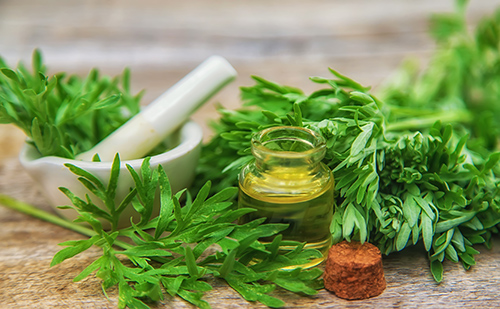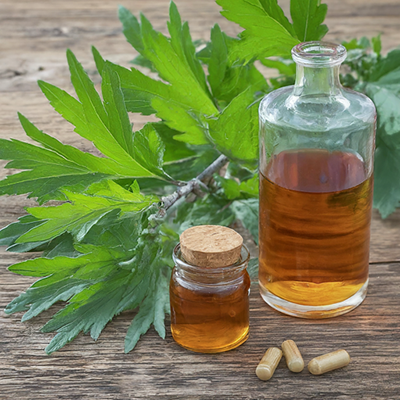Contents
The ancient Greeks knew about mugwort as early as the 1st century. Dioscorides, the father of phytotherapy, discussed this plant. Andres de Laguna, a famous Spanish physician of the 16th century who worked in the Netherlands, Bologna, Rome, and Venice, said of this plant that “it is called Artemisia, from the name of the goddess Artemis, also called Diana, since, like the goddess, the plant helps women in labor without ever failing.”
Mugwort has always been used because of its effects on female genitals. With its characteristic finesse, the French medical school said as early as the Renaissance that “mugwort turns women into flowers again,” meaning the plant’s effects on menstruation.

Mugwort Scientific Facts
- Other names are Artemisia, common mugwort, felon herb, and sailor’s tobacco.
- French – Armoise.
- Spanish – Artemisa.
- Environment – Prevalent in all kinds of soils of Europe and warm climate areas of America.
- Description—This is a vibrant plant of the Compositae family, like wormwood but taller (60-120 cm high). Its stem is reddish, and its leaves are silver on their undersides. Each flower chapter comprises 10 to 12 tiny yellow or reddish flowers.
- Parts of the plant used medicinally – The leaves and the flower clusters in summer and the root in fall.
Healing Properties
The entire plant contains an essence whose main component is eucalyptol or cineole and lesser amounts of thujone, tannin, mucilage, and a bitter component. Its properties are as follows:
- Emmenagogue—It can produce menstruation in the case of amenorrhea, a lack of menstruation due to functional disorders. Mugwort also has the properties of normalizing the menstrual cycle and easing menstrual pain (dysmenorrhea). In ancient times, it was applied as poultices on women’s stomachs suffering from difficult or prolonged labor. Fortunately, we have better remedies to accelerate delivery at present.
- Appetizer and cholagogue – Because of its bitter component, it has the following properties:
– increases appetite
– stimulates the emptying of the stomach (recommended for gastric ptosis)
– promotes digestion
– normalizes the function of the gallbladder
– the plant also has mild laxative properties - Vermifuge – It produces expulsion of intestinal parasites. It is especially effective against oxyuridae. In Central America, mugwort is widely used because of this action.

This plant was formerly used as a sedative to treat epilepsy and Parkinson’s disease. However, today it is no longer used. We have no proof of its effectiveness in these cases.
Mugwort makes an excellent remedy for those seeking relief from controllable shaking, insomnia, and nervousness. The herb is also helpful in treating menstrual cramps, suppressed menstruation, and other female problems. The herb’s effect can be enhanced with black haw, marigold, and cramp bark.
Mugwort can bring on the menstrual period, and it is utilized with cramp bark to alleviate menstrual cramps and other miscellaneous issues. The tea can also help treat stomach ailments. Dilute it three times to overcome the strong taste. For bowel and stomach pains, consume the tea in frequent small doses and pour the infusion over the problematic area.
It is helpful in combination with other herbs that treat kidney stones. Native Americans used it to treat fevers, bronchitis, colds, and flu. Taking it hot makes for excellent sweating therapy. This herb also benefits people suffering from swollen glands, epilepsy, earache, hay fever, difficulty breathing, and asthma.
External application as a poultice can treat abscesses, carbuncles, and boils. Some experiments show promise in mugwort’s ability to lower blood sugar and possess some components that have antifungal and antibacterial properties.
Warning
This plant can negatively affect the nervous system like wormwood when the recommended doses are widely exceeded or taken for more than ten days. Pregnant women must avoid it since it is likely to have abortifacient properties. Breastfeeding women must also refrain from taking this plant because it gives the milk a bitter flavor.

Mugwort Baths
For menstruation disorders, it is helpful to enjoy a combination of oral intake of this plant with hot water baths to which some handfuls of mugwort are added.
How to use Mugwort
- Infusion.
- As a vermifuge, the patient must drink a cup on an empty stomach and two more before every meal for three days when dealing with intestinal parasites. Repeat another cycle one week later.
Infusion: Steep for twenty minutes and take one teaspoon as needed. Tincture: Take thirty to sixty drops as needed. Fluid Extract: Take one teaspoon as needed. Powder: Take up to ten #0 capsules (up to 60 grains) as required.
Other Artemisia Species
In tropical areas of the Americas, several species and varieties are very similar to mugwort, which have the same properties, such as the Artemisia draculoides Pursh., cultivated in North America where it is called false tarragon.
DISCLAIMER: All content on this website is presented solely for educational and informational objectives. Do not rely on the information provided as a replacement for advice, diagnosis, or treatment from a qualified medical expert. If you are pregnant, nursing, or have any preexisting medical concerns, talk to your doctor before using any herbal or natural medicines.
REFERENCES
- George D. Pamplona-Roger, M.D. “Encyclopedia of Medicinal Plants.” George D. Pamplona-Roger, M.D. Encyclopedia of Medicinal Plants. Ed. Francesc X. Gelabert. vols. 2 San Fernando de Henares: Editorial Safeliz, 2000. 624, 625. Print.
- Vance Ferrell Harold M. Cherne, M.D. The Natural Remedies Encyclopedia [Book]. – Altamont, TN: Harvestime Books, 2010. – Vol. Seventh Edition: 7: pp. 169.
- WebMD https://www.webmd.com/
- Mayo Clinic https://www.mayoclinic.org/
